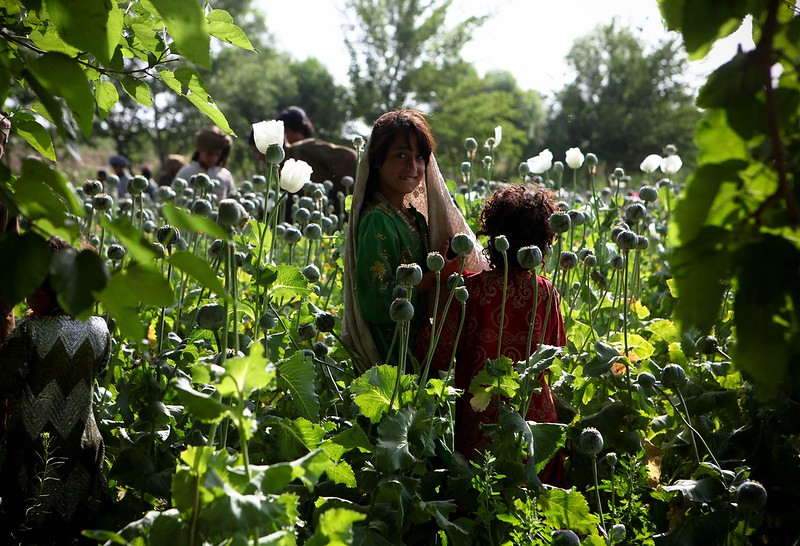
The Taliban’s recent ban on opium cultivation in Afghanistan, a repeat of previous attempts under Taliban rule up to 2001, shows how large-scale illicit drug economies are a fierce vector for organised crime and terrorism. The ban was announced last month in response to international demands for greater drug control in the country. It prohibits the buying, selling and use of a range of illicit drugs as well as alcohol.
In making the announcement, the Taliban leadership asked for the international community’s cooperation to help opium farmers find alternative businesses.
To be remotely effective or sustainable, the strategies the international community employs to reduce this huge economy must address it as a geostrategic security challenge for Afghanistan and the region. It’s not simply a law enforcement issue, however multilateral. Nor is it purely a humanitarian issue, though that’s a key and critically urgent element (and is the subject of a companion piece to be published on this forum).
The short-lived opium ban the Taliban implemented in 2000 was validated by the UN Office on Drugs and Crime after 10 months as ‘successful’ in stopping poppy cultivation in Taliban-controlled areas. The group rescinded the decree in September 2001, probably because of the political cost and economic pressure. This was just before the 9/11 attacks on the US and the military operations in Afghanistan that followed, so the sustainability of the ban was never proven. Cultivation has risen ever since. Earlier bans and reduction attempts in 1997 and 1999 were reportedly completely ineffective.
The Taliban and international community are well aware that the opium harvest provides major funding opportunities to non-state actors who seek to destabilise governments (just as the Taliban did themselves, and never to greater profit than during the US occupation that ended last year). Illicit drugs in general are known to fund organised crime and terrorism. Illicit drug production and trafficking have long been hallmarks of insecure states and conflict zones—examples include Myanmar under the current military junta, Colombia and Afghanistan since the 1980s.
Instability and low levels of governance provide opportunities for organised crime to operate unencumbered by law enforcement, and corrupt regimes and non-state actors can take a fat cut of criminal profits by allowing business to proceed. Afghan opium exports have been at historic highs for five consecutive years, at more than 6,000 tons worth US$1.8–2.7 billion annually. That’s a lot of funding potential for crime and terrorism in the region, for which the US’s 2001 military operation intended to remove the enabling conditions.
The UNODC warns that ‘shrinking the licit economy can make drug markets a larger share of the national economy’ and, without alternative avenues for income generation, stimulate more illegal activities. The withholding of international aid after the Taliban returned to power in 2021 has significantly reduced Afghanistan’s legitimate economy and is projected to shrink the country’s GDP by 20% within the year (perhaps the greatest indictment of the US-led nation-building agenda). From 6–11% of GDP in November 2021, the opium economy rose to 7.5–14% of GDP in 2022.
With the collapse of government and health services in the absence of aid funding, a lot of people are left without jobs or basic services and vulnerable to whatever options remain. The UNODC warns that options abound in the illicit drug economy, particularly in the production of synthetic opioids and methamphetamine. Global and regional demand are high and growing, and significantly higher seizures since 2018 in Afghanistan suggest production is also on the rise (182 kilograms of methamphetamine were seized in 2018 compared with more than 1,200 kilograms in 2019 and 2020).
During the short ban of 2000, the Taliban may have temporarily stemmed the flow of Afghan opium out to the world, but they kept profiting from international markets because the restricted supply caused the farmgate price to soar to 21 times the pre-ban value. Meanwhile, unverified rumours suggested that the group stockpiled large quantities of opium to ensure continuity in funding.
The Taliban’s banning of the crop in response to international demands will have the greatest effect on rural communities, rendering them destitute and inexorably indebted (to opium traders). There is no empirical evidence to suggest that it will reliably or significantly reduce the global heroin supply or curtail the Taliban’s profits from it.
The Taliban calculus on the drug trade has now clearly shifted. In 1996, within two years of its formation, the group was taxing opium farmers and traders for significant profits instead of earnestly enforcing bans. In the more than 20 years since, the Taliban profited from the trade in the fashion typical of non-state groups seeking to destabilise a government—that is, both financially by enabling and taxing activities in areas they controlled and socially by extracting allegiance from the rural communities for whom the government-mandated bans, without alternative income sources, meant abject poverty.
Today, the Taliban are faced with consolidating power as the government of a profoundly failed and increasingly forgotten state. Afghanistan is haemorrhaging the international aid money that provides basic services to its people, who are already experiencing acute food insecurity and a wholesale humanitarian crisis. The Islamic State Khorasan terror group is stepping into the role of the primary non-state actor threatening security and stability in Afghanistan and the near region—a role only recently vacated by the Taliban themselves.
The new ban will likely turn rural communities suffering from income loss away from the source of this pain (the government) and toward its challengers, like IS-K. That’s even more likely given the high volume of indiscriminate violence the Taliban are levying, so far unsuccessfully, to weed out IS-K.
These intersecting threats rhyme with those of the 1990s. It can’t be long before our waning attention to the accelerating humanitarian crisis in Taliban Afghanistan is pulled acutely back to the region by another, consequent security crisis.
As long as Afghanistan is left a failed state, the illicit drug trade will boom, and with it organised crime and terrorist activity.

